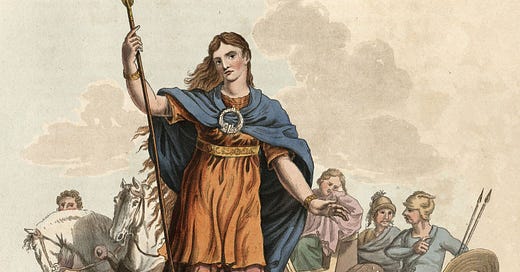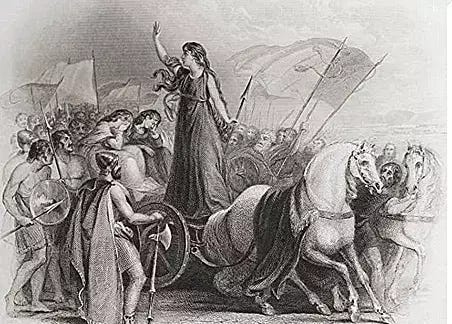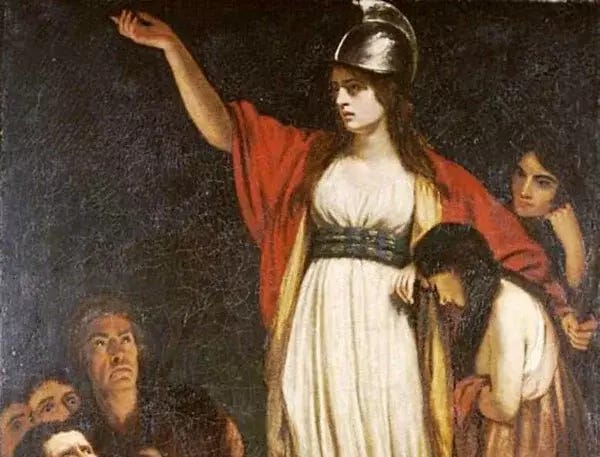Boudicca: The Importance of Standing Against Tyranny and Injustice
A guest article by Sarah Donaghue | March 2025
Her story will resonate with anyone who has ever felt oppressed or marginalised, and her courage will help to inspire those who fight for their rights and freedoms. Her legacy serves as a powerful reminder that even in the face of overwhelming odds, the human spirit can rise up and resist.
About Sarah Donaghue, this week’s guest writer
Sarah is a software engineer, medieval history enthusiast, and perpetual bookworm. She has a background in Politics & History, a Master’s in Computer Science, and is currently pursuing a second Master’s in Medieval History. When she’s not coding or buried in research, you’ll find her reading fantasy novels, playing music, or hanging out with her dog.
You can read more of her work on Substack at the link below.
If you’re new here, the Society of History Writers is founded upon the principle of collaboration. It’s the ONLY space on Substack dedicated to bringing writers of history and historical fiction together to share their experience, grow in their craft, and share their writing exclusively with a growing worldwide audience. I am honoured to provide this space to spotlight your writing and share it with colleagues and readers across the world.
Boudicca: The Importance of Standing Against Tyranny and Injustice
Sarah Donaghue
In the archives of history, few figures stand as boldly as Boudicca, the Celtic warrior queen who defied the power of the Roman Empire. Her story is one of courage, resilience, and an unyielding desire for justice. Boudicca’s rebellion against the Romans in 60-61 AD remains a powerful symbol of resistance against oppression, and her legacy continues to inspire generations. Her story is one of resilience, as she overcame personal tragedy to lead a monumental uprising, challenging the most powerful empire of her time.
Who Was Boudicca?
Boudicca (also spelled Boudica or Boadicea) was the queen of the Iceni, a Celtic tribe located in what is now modern-day Norfolk in eastern England. The Iceni were one of the many tribes in Britannia who had managed to maintain a fragile peace with the Romans after their invasion in 43 AD. Under the rule of Boudicca’s husband, King Prasutagus, who ruled as a nominally independent client-king, the Iceni maintained a fragile alliance with Rome.
However, this uneasy peace was shattered following Prasutagus’s death. In his will, he had left his kingdom jointly to his two daughters and the Roman Emperor Nero, aiming to preserve his family's status and protect his realm from direct annexation. But the Romans, notorious for their greed and disregard for local customs, saw an opportunity to expand their control. They seized Iceni lands, plundered their wealth, and subjected the royal family to severe brutality: Boudicca was flogged and her daughters were assaulted. These atrocities ignited Boudicca's fervent desire for vengeance and became the catalyst for one of the most dramatic rebellions in Roman history.
The Spark of Rebellion
Boudicca’s rebellion was not merely a personal vendetta; it was a response to widespread Roman exploitation and cruelty. Many Celtic tribes harbored deep-seated resentment toward Roman rule due to heavy taxation, land confiscation, and cultural suppression. Many tribes across Britannia shared the Iceni’s grievances, and Boudicca’s call to arms resonated deeply. She quickly amassed a formidable army of warriors, uniting tribes such as the Trinovantes and others who had suffered under Roman rule.
In 60 AD, Boudicca led her forces in a series of devastating attacks on Roman settlements. Her first target was Camulodunum (modern-day Colchester), a symbol of Roman authority and a colony for retired soldiers. The city was poorly defended, and Boudicca’s army overwhelmed it with ease. Camulodunum was razed to the ground, and its inhabitants were slaughtered. The destruction was so complete that archaeologists have found a distinct layer of ash and debris dating to this period, a haunting reminder of the rebellion’s ferocity.
Emboldened by this victory, Boudicca’s army marched on Londinium (London), a thriving commercial hub and a key Roman administrative center. Gaius Suetonius Paulinus, the Roman governor, realized he could not defend the city and evacuated as many people as possible. When Boudicca’s forces arrived, they burned Londinium to the ground and massacred those who remained. The same fate befell Verulamium (St. Albans), a town loyal to Rome. Tacitus, the Roman historian, recorded that Boudicca’s forces killed an estimated 70,000 Romans and pro-Roman Britons during their campaign.
The rebellion sent shockwaves through the Roman Empire. For a brief moment, it seemed as though the Romans might be driven out of Britannia altogether. Boudicca’s success was not just a military triumph; it was a psychological blow to Roman invincibility. Her ability to unite disparate tribes and strike at the heart of Roman power demonstrated her extraordinary leadership abilities and the depth of resentment against Roman rule.
The Turning Point
Despite her early successes, Boudicca’s rebellion faced a formidable opponent in Gaius Suetonius Paulinus, the Roman governor. A seasoned military commander, he quickly regrouped his forces and prepared for a decisive battle. The Romans, though outnumbered, were highly disciplined and well-equipped. They also had the advantage of superior tactics and organization.
The two armies finally clashed in a location believed to be somewhere in the West Midlands, though the exact site remains unknown. Suetonius chose a narrow battlefield with dense forests at his back, limiting the effectiveness of Boudicca’s superior numbers. The Romans formed a tight defensive formation, using their shields and short swords to devastating effect. Boudicca’s forces, while fierce and numerous, were no match for the Roman legions. The battle ended in a crushing defeat for the Celts and Boudicca’s dream of liberating Britannia was extinguished.
The Fate of Boudicca
The fate of Boudicca herself is shrouded in mystery. According to Tacitus, she died by suicide shortly after her defeat, choosing to end her life rather than face capture and humiliation at the hands of the Romans. Conversely, Cassius Dio suggests she fell ill and died, though this version is less widely accepted. Regardless of the details, Boudicca’s death marked the end of her rebellion and the reassertion of Roman control over Britannia.
The Romans, determined to prevent future uprisings, tightened their grip on the province. They increased their military presence, imposed harsher penalties on rebellious tribes, and worked to assimilate the local population into Roman culture. Yet despite their efforts, Boudicca’s legacy endured.
Boudicca in Literature and Culture
Boudicca’s story has captured the imagination of writers, artists, and filmmakers for centuries. In the 16th and 17th centuries, she became a symbol of British nationalism and resistance to foreign domination. The playwright John Fletcher wrote a tragedy titled Bonduca in 1613, while the poet William Cowper celebrated her in his 1782 poem Boadicea: An Ode.
In the 19th century, Boudicca was embraced as a feminist icon, a woman who defied the patriarchal norms of her time to lead her people in battle. Thomas Thornycroft’s iconic statue of Boudicca, located near Westminster Bridge in London, depicts her standing proudly in a chariot, her daughters by her side. The statue captures the spirit of a woman who refused to bow to tyranny, even in the face of overwhelming odds. This interpretation has persisted into the modern era, with Boudicca appearing in novels, television shows, and video games.
Boudicca’s rebellion may have failed, but her story has resonated through the centuries. She has been celebrated as a national heroine in Britain, a symbol of resistance against oppression and injustice. Her defiance against one of the greatest empires of the ancient world has made her an enduring icon of strength and resilience.
Why Boudicca Matters Today
To fully understand Boudicca’s rebellion, it is essential to consider the broader historical context. The Roman invasion of Britannia in 43 AD was part of the empire’s expansionist policies under Emperor Claudius. The Romans sought to exploit the island’s resources, including its fertile land and mineral wealth. However, their arrival disrupted the existing social and political structures of the Celtic tribes.
The Celts who had lived in Britannia for centuries were a diverse group of tribes with their own customs, languages, and leaders. While some tribes, like the Iceni, initially cooperated with the Romans, others resisted fiercely. The Roman policy of client-kingship, which allowed local rulers to maintain their authority in exchange for loyalty, was often rife with tension. The Romans frequently exploited those arrangements, which led to resentment and rebellion.
Boudicca’s uprising was not an isolated event but part of a broader pattern of resistance to Roman rule. Other notable rebellions include the revolt of the Brigantes under Queen Cartimandua and the later uprising led by the Caledonian chieftain Calgacus. Boudicca’s rebellion, however, stands out for its scale, its impact, and the remarkable leadership of its queen.
Boudicca’s rebellion is more than just a historical event: it’s a reminder of the importance of standing up against tyranny and injustice. Her story will resonate with anyone who has ever felt oppressed or marginalised, and her courage will help to inspire those who fight for their rights and freedoms. Her legacy serves as a powerful reminder that even in the face of overwhelming odds, the human spirit can rise up and resist. She may have lived nearly 2,000 years ago, but her story is timeless; it’s a beacon of hope and defiance for generations to come.
Boudicca, the Celtic warrior queen, may have fallen in battle, but her spirit lives on. Her rebellion against the Romans is a story of courage, resilience, and the unyielding desire for justice. It is a reminder that even in the face of overwhelming odds, the human spirit can rise and resist. Boudicca’s legacy is a beacon of hope and defiance, a symbol of the enduring fight for freedom and equality. Her story is not just a chapter in history: it is a timeless tale that continues to inspire and empower.
Thank you Sarah!
Make sure to let Sarah know what you thought in the comments, and share this post with anyone you think would enjoy reading about Boudicca.
If you enjoyed this extract, here are three recent guest posts featured on the Society of History Writers.
Sources:
BBC:
https://www.bbc.co.uk/history/historic_figures/boudicca.shtml
Britannica:
https://www.britannica.com/biography/Boudicca
History Hit:
https://www.historyhit.com/what-caused-boudiccas-great-british-revolt-against-roman-rule/
PBS:
https://www.pbs.org/empires/romans/empire/boudica.html
Roman Britain:
The University of Warwick: https://warwick.ac.uk/fac/arts/classics/warwickclassicsnetwork/romancoventry/resources/boudica/revolt/















I've read and heard that one of the complications in the succession arrangements was that the Romans did not recognize any succession in a client state that transferred power from a male ruler to a female?
Great read. This story should be taught in schools throughout the United Kingdom